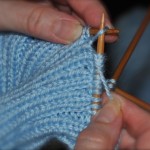 You can check out my Knitting Nancy blog to see exactly how to make a spool and how to start your yarn to begin forming your tail! As you can see by the picture, my “tail” is quite long, presently measuring 131 inches or a little over 3 1/2 yards long. My goal is to roll my tail into a circle to make a nice trivet or mat for a hot bowl to protect the dining table top.
You can check out my Knitting Nancy blog to see exactly how to make a spool and how to start your yarn to begin forming your tail! As you can see by the picture, my “tail” is quite long, presently measuring 131 inches or a little over 3 1/2 yards long. My goal is to roll my tail into a circle to make a nice trivet or mat for a hot bowl to protect the dining table top.
 At present, it measures almost 8 inches in diameter and I think I will make it just a little wider but probably not more than 10 inches. Of course, this will leave me with just enough yarn to make a small pom pom!! Yarn scraps?? hmm – working on some ways to use them up because I just cannot bear to trash them or maybe I will find a local 4H group and donate all my tiny yarn balls to them. Like that idea!!
At present, it measures almost 8 inches in diameter and I think I will make it just a little wider but probably not more than 10 inches. Of course, this will leave me with just enough yarn to make a small pom pom!! Yarn scraps?? hmm – working on some ways to use them up because I just cannot bear to trash them or maybe I will find a local 4H group and donate all my tiny yarn balls to them. Like that idea!!
 Anyways I digress, my trivet will be sewn together with a nice quilting weight cotton thread. Connecting Threads has some great collections of these threads in a wide variety of colors too, which are wonderful for machine or hand sewing projects.
I think I started a new skein of yarn for this project, a category 4 yarn, worsted weight. I just used a size 5 hook to lift my lower loop over the top loop to create the knit looking tail.
Anyways I digress, my trivet will be sewn together with a nice quilting weight cotton thread. Connecting Threads has some great collections of these threads in a wide variety of colors too, which are wonderful for machine or hand sewing projects.
I think I started a new skein of yarn for this project, a category 4 yarn, worsted weight. I just used a size 5 hook to lift my lower loop over the top loop to create the knit looking tail.
 When I am ready to bind off, I will do another blog with close up pictures so you can see the actual binding off process.
Some fun ideas to use your “tail” for would be a set of coasters, cool bookmarks, glue some googlie eyes and make a snake for a little one, make three tails and sew together at one end and braid them for a bracelet or headband, placemats even a small rug.
I’m looking forward to completing this one and having it ready for my kitchen table!!
When I am ready to bind off, I will do another blog with close up pictures so you can see the actual binding off process.
Some fun ideas to use your “tail” for would be a set of coasters, cool bookmarks, glue some googlie eyes and make a snake for a little one, make three tails and sew together at one end and braid them for a bracelet or headband, placemats even a small rug.
I’m looking forward to completing this one and having it ready for my kitchen table!!
HAPPY CREATING!!
Disclaimer: This post contains affiliate links – “Commissions Earned”















